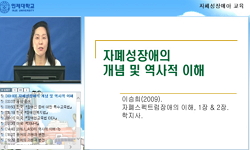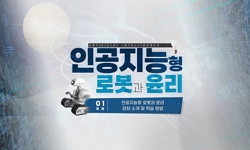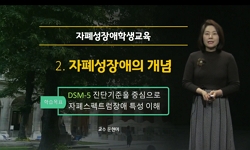본 연구에서는 로봇을 이용한 특수학급에서의 수업 상황, 로봇이 없는 특수학급 수업 상황, 그리고 로봇이 없는 일반 학급 수업 상황에서 자폐성 장애 아동의 언어 환경적 특성을 비교하고 ...
http://chineseinput.net/에서 pinyin(병음)방식으로 중국어를 변환할 수 있습니다.
변환된 중국어를 복사하여 사용하시면 됩니다.
- 中文 을 입력하시려면 zhongwen을 입력하시고 space를누르시면됩니다.
- 北京 을 입력하시려면 beijing을 입력하시고 space를 누르시면 됩니다.

일반학급, 특수학급, 로봇 환경에서의 중등도 자폐성 장애 아동의 언어적 상호작용 = Language environment and interaction of a child with moderate autism: Comparison of robot-mediated instruction, special education, and inclusive education settings
한글로보기https://www.riss.kr/link?id=A103850563
- 저자
- 발행기관
- 학술지명
- 권호사항
-
발행연도
2013
-
작성언어
Korean
- 주제어
-
등재정보
KCI등재
-
자료형태
학술저널
-
수록면
19-38(20쪽)
-
KCI 피인용횟수
8
- 제공처
-
0
상세조회 -
0
다운로드
부가정보
국문 초록 (Abstract)
본 연구에서는 로봇을 이용한 특수학급에서의 수업 상황, 로봇이 없는 특수학급 수업 상황, 그리고 로봇이 없는 일반 학급 수업 상황에서 자폐성 장애 아동의 언어 환경적 특성을 비교하고 아동의 언어적 상호작용에 있어서 차이가 있는지 살펴보았으며 3주 동안의 추이를 비교해 보았다. 연구 결과, 언어 환경에 있어서 세 조건 간에는 대부분 통계적으로 유의한 차이가 없었으나 침묵에서만 유의한 차이가 있었다. 언어적 상호작용에 있어서는 발화, 단어 말하기, 구어적 상호작용 세 가지를 분석하였는데, 통계적으로는 유의한 차이가 없었으나 시간에 따른 추이를 살펴 본 결과 중재 시작 시 발화, 단어, 구어적 상호작용 모두에 있어 로봇이 높게 시작했으나 시간이 갈수록 떨어져 나중에는 특수학급이나 일반학급 수업 상황 보다도 더 떨어지는 것으로 나타났다. 또한 이러한 변화는 통계적으로도 유의했다.
다국어 초록 (Multilingual Abstract)
In the current study, we compared the language environment and changes in interaction of a child with autism spectrum disorders during robot-mediated instruction, special education classroom, and inclusive classroom for the period of 3-weeks. The resu...
In the current study, we compared the language environment and changes in interaction of a child with autism spectrum disorders during robot-mediated instruction, special education classroom, and inclusive classroom for the period of 3-weeks. The results indicate that there were no significant differences between the three conditions except for the amount of silence. As for verbal interaction, numbers of spontaneous communication, word production, and verbal interaction were counted. The results showed that there were no signficant differences between the three conditions, however, all correlation tests proved to be significant across time. We found that in robot condition, spontaneous communication, word production, and verbal interaction started higher than special education or inclusive education settings. However, as time passed, the decrease rate was significantly higher than the other two.
참고문헌 (Reference)
1 지식경제부, "제1차 지능형 로봇 기본 계획 2010년 실행 계획" 지식경제부 2010
2 Moore, M., "rief Report: Vocabulary acquisition for children with autism: Teacher or computer instruction" 30 (30): 359-362, 2000
3 Klin, A., "Young autistic children's listening preferences in regard to speech: A possible characterization of the symptom of social withdrawal" 21 : 29-42, 1991
4 Striblin, P., "Using conversation analysis to explore the recurrence of a topic in the talk of a boy with autism spectrum disorder" 23 : 555-582, 2009
5 Ploog, B., "Use of computer-assisted technologies(CAT) to enhance social, communicative, and language development in children with autism spectrum disorders" 43 (43): 301-322, 2013
6 Dautenhahn, K., "Towards interactive robots in autism therapy" 12 (12): 1-35, 2004
7 Feil-Seifer, D., "Toward social assistive robotics for augmenting interventions for children with autism spectrum disorders" 54 : 201-210, 2009
8 Wainer, A., "The use of innovative computer technology for teaching social communication to individuals with autism spectrum disorders" 5 (5): 96-107, 2011
9 Bruner, J., "The ontogenesis of speech acts" 2 (2): 1-19, 1975
10 Srinivasan, S., "The effect of -robot-child interactions on social attention and verbalization patterns of typically developing children and children with autism between 4 and 8 years" 3 (3): 111-118, 2013
1 지식경제부, "제1차 지능형 로봇 기본 계획 2010년 실행 계획" 지식경제부 2010
2 Moore, M., "rief Report: Vocabulary acquisition for children with autism: Teacher or computer instruction" 30 (30): 359-362, 2000
3 Klin, A., "Young autistic children's listening preferences in regard to speech: A possible characterization of the symptom of social withdrawal" 21 : 29-42, 1991
4 Striblin, P., "Using conversation analysis to explore the recurrence of a topic in the talk of a boy with autism spectrum disorder" 23 : 555-582, 2009
5 Ploog, B., "Use of computer-assisted technologies(CAT) to enhance social, communicative, and language development in children with autism spectrum disorders" 43 (43): 301-322, 2013
6 Dautenhahn, K., "Towards interactive robots in autism therapy" 12 (12): 1-35, 2004
7 Feil-Seifer, D., "Toward social assistive robotics for augmenting interventions for children with autism spectrum disorders" 54 : 201-210, 2009
8 Wainer, A., "The use of innovative computer technology for teaching social communication to individuals with autism spectrum disorders" 5 (5): 96-107, 2011
9 Bruner, J., "The ontogenesis of speech acts" 2 (2): 1-19, 1975
10 Srinivasan, S., "The effect of -robot-child interactions on social attention and verbalization patterns of typically developing children and children with autism between 4 and 8 years" 3 (3): 111-118, 2013
11 Whalen, C., "The collateral effects of joint attention training on social initiations, positive affect, imitation, and spontaneous speech for young children with autism" 36 : 655-664, 2006
12 Diehl, J., "The clinical use of robots for individuals with autism spectrum disorders: A critical review" 6 : 249-262, 2012
13 Kim, E., "Social robots as embedded reinforcers of social behavior in children with autism" 43 : 1038-1049, 2013
14 Pierno, A. C., "Robotic movement elicits visuomotor priming in children with autism" 46 : 448-454, 2008
15 Stanton, C. M., "Robotic animals might aid in the social development of children with autism, In Proceedings of the ACM/IEEE interantional conference on human-robot interaction" ACM Press 271-280, 2008
16 Jarold, C., "Review of research into pretend play in autism" 7 (7): 379-390, 2003
17 Gravetter, F. J., "Research methods 4e: For the behavioral sciences" Wadsworth 2009
18 Bono, M., "Relations among joint attention, amount of intervention and language gain in autism" 34 (34): 495-505, 2004
19 Lillard, A. S., "Pretend play skills and the child's theory of mind" 64 (64): 348-371, 1993
20 Charman, T., "Predicting language outcome in infants with autism and pervasive developmental disorder" 38 : 265-285, 2003
21 Venuti, P., "Maternal functional speech to children: A comparison of autism spectrum disorder, Down syndrome, and typical development" 33 : 506-517, 2012
22 Lord, C., "Longitudinal studies of young children referred for possible autism" 1996
23 Kasari, C., "Language outcome in autism: Randomized comparison of joint attention and play interventions" 76 (76): 125-137, 2008
24 Mundy, P., "Joint attention and social-emotional approach behavior in children with autism" 7 : 63-82, 1995
25 Loveland, K., "Joint attention and language in autism and developmental language delay" 16 (16): 335-349, 1986
26 Duquette, A., "Exploring the use of a mobile robot as an imitation agent with children with low-functioning autism" 24 : 147-157, 2008
27 Pioggia, G., "Exploring emotional and imitational android-based interactions in autistic spectrum disorders" 1 : 49-62, 2008
28 Le Couteur, A., "Epidemiologically based twin study of autism" 1989
29 Giannopulu, I., "Embedded multimodal nonverbal and verbal interactions between a mobile toy robot and autistic children" 127-128, 2013
30 Hetzroni, O., "Effects of a computer-based intervention program on the communicative functions of children with autism" 34 (34): 95-113, 2004
31 Merchant, Z., "Effectivness of virtual reality-based instruction on students' learning outcomes in K-12 and higher education: A meta-analysis" 70 : 29-40, 2014
32 Howlin, P., "Echolalic and spontaneous phrase speech in autistic children" 23 (23): 281-293, 1981
33 Osterling, J., "Early recognition of children with autism: A study of first birthday home videotapes" 24 : 247-257, 1994
34 Williams, C., "Do children with autism learn to read more readily by computer assisted instruction or traditional book methods? A pilot study" 6 (6): 71-91, 2002
35 Mundy, P., "Defining the social deficits of autism: The contribution of non-verbal communication measures" 27 (27): 657-669, 1986
36 Tager-Flusberg, H., "Communication in autism, In Handbook of autism and pervasive developmental disorders" Wiley & Sons 335-364, 2005
37 Kozima, H., "Children-robot interaction: A pilot study in autism therapy" 174 : 385-400, 2007
38 Sigman, M., "Children with autism: A developmental perspective" Harvard University Press 1997
39 Christakis, D., "Audible television and decreased adult words, infant vocalization, and conversational turns: A population-based study" 163 (163): 554-558, 2009
동일학술지(권/호) 다른 논문
-
- 한국자폐학회
- 황윤숙
- 2013
- KCI등재
-
2-4세 일반아동의 자발화 표본크기와 평균발화길이의 비교
- 한국자폐학회
- 정부자
- 2013
- KCI등재
-
고기능 자폐범주성장애 초등학생의 구체어 및 추상어 산출: 명사와 동사를 중심으로
- 한국자폐학회
- 이윤경
- 2013
- KCI등재
-
- 한국자폐학회
- 이희란
- 2013
- KCI등재
분석정보
인용정보 인용지수 설명보기
학술지 이력
| 연월일 | 이력구분 | 이력상세 | 등재구분 |
|---|---|---|---|
| 2028 | 평가예정 | 재인증평가 신청대상 (재인증) | |
| 2022-01-01 | 평가 | 등재학술지 유지 (재인증) |  |
| 2019-01-01 | 평가 | 등재학술지 유지 (계속평가) |  |
| 2016-01-01 | 평가 | 등재학술지 유지 (계속평가) |  |
| 2012-01-01 | 평가 | 등재학술지 선정 (등재후보2차) |  |
| 2011-01-01 | 평가 | 등재후보 1차 PASS (등재후보1차) |  |
| 2009-01-01 | 평가 | 등재후보학술지 선정 (신규평가) |  |
학술지 인용정보
| 기준연도 | WOS-KCI 통합IF(2년) | KCIF(2년) | KCIF(3년) |
|---|---|---|---|
| 2016 | 1.83 | 1.83 | 1.68 |
| KCIF(4년) | KCIF(5년) | 중심성지수(3년) | 즉시성지수 |
| 1.67 | 1.64 | 2.126 | 0.5 |





 KCI
KCI 스콜라
스콜라






